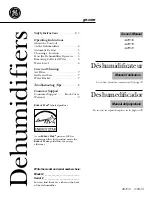
14
•Do not leave the appliance unattended in closed rooms, as the air may become saturated and leave
condensation on walls and furniture. Always leave the room door/window partially open.
•In cold weather, windows may fog or develop frost from excessive indoor humidity. If this occurs, reduce the
mist intensity setting to avoid damages from the condensed water.
•Excessively high humidity in the room may cause moisture to accumulate on surfaces where bacteria and fungi
can grow. The excessive humidity can also damage furniture, walls and wall papers.
•The nozzle of the humidifier, responsible for spreading the mist, must not be pointed towards walls and
furniture.
IDEAL HUMIDITY IN DIFFERENT ENVIRONMENTS
1.BEDROOM, LIVING ROOM, CHILDREN’S ROOM:
45-64 % rel. humidity
2.ROOM WITH COMUTER:
45-60 % rel. humidity
3.ROOM WITH PIANO:
40-60 % rel. humidity
4.HOSPITAL ROOM:
40-55 % rel. humidity
5.LIBRARY:
40-50% rel. humidity
•Before use for the first time, clean well the appliance.
•Before you start cleaning the product, turn it off from the ON/ OFF switch, unplug the power cord and wait until
the appliance cools down.
•Do not use strong cleansers - bleach, alcohol-based ones (anti-bacterial wet wipes) or such with abrasive
particles.
•Wipe the exterior of the body with a damp cloth.
•After you clean the whole appliance, leave it to dry complete before you start using it again.
•
Warning!
Do not wet the bottom outer part of the base in order not to damage the electric parts of the product.
•Clean the ultrasonic transducer with clean water.
•Do not use soap or other chemical substances to clean the transducer.
A.Cleaning the water tank and the mist tube:
1.Clean the water tank and the mist tube at least every 3 days.
2.Remove the cap of the water tank. Pour inside the tank water solution and detergent. Place back the cap and
shake the tank well several times. Pour out the solution from the tank and wash well with water.
3.If there is scale in the water tank, use soft cloth and vinegar to clean it.
4.Keep the nebulizer and water sensor free of mineral deposits. You can clean the nebulizer and water sensor
with a soft brush. Do not scrape the nebulizer or water sensor . Do not clean with tools that have metal parts.
5.If there is lime scale on the safety switch, spray it with several drops of vinegar and clean it with brush. Clean
with fresh water.
6.The mist tube you can wipe with soft wet cloth and mild detergent. If there is lime scale on it, use vinegar to
clean it. Rinse with clean water.
B.Cleaning the fragrance container:
1.Fragrance container can be rinsed with warm water and mild detergent.
2.The cotton diffuser stick cannot be cleaned. In case of excessive use, it shall be replaced with a new one.
Warning!
Leaving water in the tank for more than a couple days may cause bacterial growth. Always empty the
tank if not planning to use for a few days.
C.Storage:
•Save the box for off-season storage
•If you will not use the product for a long time, the water tank, the base, fragrance container, and all parts shall
be well cleaned and left to dry completely, before storage.
•If water is left on the unit during the storage, it may harden and leave deposits that may affect the unit from
operating properly.
•Leave the cap of the water tank loose. This will prevent the cap and gasket from sticking together and prolong
the life of the gasket.
• Put it in a dry and airy place away from children reach.
INSTRUCTIONS FOR MAINTENANCE AND CLEANING OF THE APPLIANCE
DISPOSAL INSTRUCTIONS
According to the European Waste Management Directive 2012/19 / EU, this symbol on the
product or on its packaging means that it must not be treated as household waste and must be
disposed of in the designated recycling area for electronic equipment.
Summary of Contents for SAH-22502
Page 2: ...1 PARTS TEILE PARTES COMPONENTE ONDERDELEN DELOVI PI CES COMPONENTI...
Page 3: ...1 2 3 4 16 5 8 6 7 8 9 10 11 12 13 14 15 16 17 18 19 220 V BG 2...
Page 7: ...6 2 3 4 5 1 2 2012 19...
Page 8: ...7 12 CANGAROO 1 02 936 07 90...
Page 10: ...9 1 2...
Page 11: ...10...
Page 23: ...22 GR 1 2 3 4 16 5 8 6 7 8 9 10 11 12 13 14 15 16 17 18 19 220 V 20...
Page 27: ...26 5 1 2 C 2012 19 12...
Page 50: ...3 4 16 5 8 6 7 8 9 10 11 12 13 14 15 16 17 18 19 220 20 21 22 23 24 49...
Page 53: ...52 30 50 50 1 45 64 2 45 60 3 40 60 4 40 55 5 40 50 ON OFF 1 3 2 3 4 5 1 2...
Page 54: ...53 2012 19 12...
Page 69: ...68 2012 19 4 5 1 2 C 12...
















































